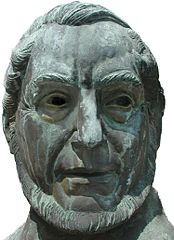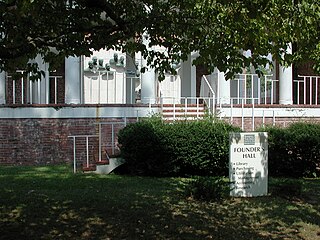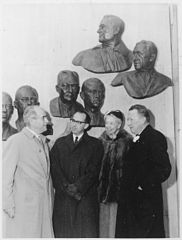Polio Hall of Fame
The Polio Hall of Fame - also known as the Polio Wall of Fame - is a collection of seventeen bronze busts of people who advanced or made possible the study of spinal palsy . It is located on the outside wall of the Founders' Hall at the Roosevelt Warm Springs Institute for Rehabilitation in Warm Springs , Georgia, USA.
Origin of the monument
The busts were created by the American sculptor Edmond Romulus Amateis on behalf of the Warm Springs Foundation. On January 2, 1958, the busts were ceremoniously unveiled in the presence of the sculptor and almost everyone still alive. The occasion of the celebration was the 20th anniversary of the National Foundation for Polio. Roosevelt's widow Eleanor Roosevelt also attended the celebration. Charles Armstrong's biographer Edward A. Beeman has published a detailed description of the unveiling ceremony with photos of the artist and the people involved.
Franklin D. Roosevelt and Warm Springs
The US President Franklin D. Roosevelt stayed regularly in the spa town of Warm Springs since 1924 and died here in 1945. In 1921 he suffered from paralysis of the legs, which was considered to be spinal polio ; According to recent research, it was the then little known Guillain-Barré syndrome . In 1927 Roosevelt founded the Georgia Warm Springs Foundation , whose main task was initially to treat spinal polio. Today the facility is called the Roosevelt Warm Springs Institute for Rehabilitation and has twenty-six different departments that care for patients with all kinds of disabilities.
Eminent polio researchers immortalized
The first fifteen of the total of seventeen bronze busts show fourteen men and one woman who were involved in research into and the fight against polio. The two people on the far right are Roosevelt and his close associate, Basil O'Connor . The order of the busts after the first four is not always chronological.
| No. | Surname | power |
|---|---|---|
| 1 | Jakob von Heine (1800–1879) | discovered and described spinal polio (1840) |
| 2 | Karl Oskar Medin (1847–1927) | discovered the contagious nature of the disease |
| 3 | Ivar Wickman (1872-1914) | Student of Medin, proved the epidemic character of the disease in field studies and coined the name Heine-Medin disease |
| 4th | Karl Landsteiner (1868–1943) | discovered the poliovirus and demonstrated the possibility of transmission to monkeys |
| 5 | Thomas M. Rivers (1888–1962) | was chairman of the committee of the National Foundation for Polio Vaccination, which carried out successful field trials with polio vaccination in 1954 |
| 6th | Charles Armstrong (1886-1967) | was a public health doctor, advocate and self-experimentation with anti-polio nasal spray |
| 7th | John R. Paul (1893-1972) | contributed significantly to knowledge about the spread of polio |
| 8th | Albert Bruce Sabin (1906-1993) | Father of the oral vaccination with live viruses |
| 9 | Thomas Francis junior (1900–1969) | was a virologist at the University of Michigan and a teacher Salks, recognized the effectiveness of the Salk vaccine |
| 10 | Joseph L. Melnick (1914-2001) | developed immunity precautions when the poliovirus appeared |
| 11 | Isabel Morgan (1911-1996) | contributed to the development of vaccines with experimental vaccinations in monkeys |
| 12 | Howard A. Howe | demonstrated that chimpanzees can be infected with polio orally |
| 13 | David Bodian (1910-1992) | showed that the virus can be stopped by antibodies in the blood |
| 14th | John F. Enders (1897–1985) | pioneered large-scale production of vaccine through his research |
| 15th | Jonas E. Salk (1914–1995) | pioneered polio vaccination on a large scale |
| 16 | Franklin D. Roosevelt (1882-1945) | founded the Warms Springs Foundation in 1927 |
| 17th | Basil O'Connor (1892–1972) | President of the National Polio Foundation since its inception (1938) and the Georgia Warm Springs Foundation after 1945 |
More pictures
Individual evidence
- ^ Edward A. Beeman: Charles Armstrong, MD: A Biography, o.O. 2007 pp. 238ff. as a PDF file see note 3
- ↑ amphilsoc.org ( Memento of the original from September 30, 2007 in the Internet Archive ) Info: The archive link was inserted automatically and has not yet been checked. Please check the original and archive link according to the instructions and then remove this notice.
- ↑ history.nih.gov (PDF; 3.8 MB)
- ^ John R. Paul: A History of Poliomyelitis , Yale University, 1971
- ↑ Howe, Howard A .: Antibody response of chimpanzees and human beings to formalin-inactivated trivalent poliomyelitis vaccine. in American Journal Of Hygiene, 1952 Nov; 56 (3) pp.265-286.
- ↑ medicalarchives.jhmi.edu ( Memento of the original dated May 9, 2007 in the Internet Archive ) Info: The archive link was inserted automatically and has not yet been checked. Please check the original and archive link according to the instructions and then remove this notice.
Coordinates: 32 ° 53 ′ 21.9 " N , 84 ° 40 ′ 59.8" W.







